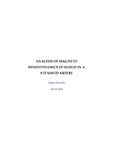| dc.description.abstract | Human body responds to physical activities, external temperature, external magnetic field, and other factors by homeostatically adjusting its blood flow in order to deliver nutrients such as oxygen and glucose to every organ in the body and allow them to function. Complications in this hemodynamic may arise due to acute coronary syndromes such as stenosis or arteriosclerosis leading to obstruction of coronary arteries. These complications do cause a change in the blood flow to the body organ as well as the amount of glucose and oxygen that is supplied to them, which may have serious effects on the functioning of some or all bodily systems. Moreover, high grade stenosis increases flow resistance in arteries which means the body has to raise the blood pressure to maintain the necessary blood flow velocity. Both the high pressure and the constricted vessels lead to high flow velocity, high shear stress and low shear stress.Thrombus formation, growth of atherosclerosis and plaque cap rupture which leads directly to stroke and heart attack are related to these irregular flows in blood.
How this works is still not well known and under investigation. A Study of how this physiological process works leads to early diagnosis, prevention and treatment stenosis related diseases. In this thesis, a theoretical study of blood flow through a stenosed artery under the combined action of thermal radiation, viscous dissipation, buoyancy force, Joule heating and an externally applied magnetic field is provided.
The stenosed artery is modelled as a symmetrical rigid wall channel containing a viscous incompressible, Newtonian, electrically conducting and optically dense biomagnetic fluid representing blood. The variable viscosity of blood depending on hematocrit (percentage by volume of erythrocytes) is taken into account in order to improve resemblance to the real situation. The governing equations of momentum and energy balance are obtained and solved both numerically using a shooting technique coupled with Runge-Kutta-Fehlberg integration method and analytically using a well-known perturbation technique. The effects of various determining parameters on the dimensionless velocity, temperature, pressure gradient, skin friction and Nusselt number are presented graphically and pertinent results are discussed. | en_US |

